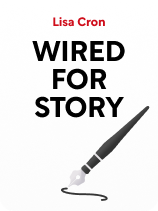

This article is an excerpt from the Shortform book guide to "Wired for Story" by Lisa Cron. Shortform has the world's best summaries and analyses of books you should be reading.
Like this article? Sign up for a free trial here.
How can your protagonist help you figure out what details to include in your story? How can you set up your protagonist for an internal struggle and, thus, advance your plot?
The protagonist is what helps you as a writer determine what details are important and what aren’t. The protagonist is who the story is about, and it’s the character your reader will need to relate to in order to feel engaged in the story and understand the importance of everything that happens.
Read more to learn how to create a protagonist, according to writer and producer Lisa Cron.
The Protagonist’s Emotion
The way the reader relates to the protagonist and understands the importance of the story’s events is through emotion. So, Cron’s first bit of guidance on how to create a protagonist is to convey information about them through their emotional state. Indeed, the importance of every detail in your story is determined by its emotional impact on the protagonist.
(Shortform note: By analyzing around 1,300 mostly fictional stories, researchers have concluded that six basic emotional arcs recur in literature. These are: rags to riches, riches to rags, man in a hole, Icarus, Cinderella, and Oedipus arcs. While a story may depict many characters, all of whom experience their own emotional journey, the story’s emotional arc is characterized by the protagonist’s emotional journey, such as the Oedipus arc in which the protagonist (roughly) goes from happy to sad to happy and then back to sad.)
Emotion is what helps us determine what information is important and what isn’t. To illustrate this neurological phenomenon, Cron shares the story of a man who suffered brain damage that took away his ability to feel emotion. Though the incident had no impact on his intelligence, memory, or problem-solving skills, he was unable to continue in his successful career because he could no longer make decisions, even minor ones. His neurologist concluded that without emotion, every option in every choice seemed neutral—and thus, was equally important and impossible to decide upon.
(Shortform note: The neurologist’s full conclusions were slightly more nuanced than Cron suggests. He argued that emotion alone doesn’t determine the choices we make. Instead, he suggests that emotion biases our choices but that we still use reason and logic to determine what we ultimately choose. Applying this to writing, it may not be enough to simply convey your characters’ emotions. You may also need to detail their thinking, problem-solving processes, and cost-benefit analyses to fully let the reader in on what’s happening and why the protagonist behaves the way they do.)
How to Convey Your Protagonist’s Emotions
In the same way that having no emotion keeps someone from assessing the importance of a piece of information, if the reader doesn’t understand the emotional impact a detail has on your protagonist, the detail will seem unimportant, and the reader won’t be interested in it. In this regard, says Cron, prose writing offers a narrative tool not available in other types of storytelling like screenwriting or playwriting: the ability to see into another person’s mind and directly understand their internal thought processes—how a piece of information is affecting them, for instance. While media like films and plays leave the viewer to intuit the characters’ emotions and thoughts, prose can convey them explicitly.
(Shortform note: There are some ways film and similar media can convey characters’ thoughts and emotions explicitly so as to imitate the power of prose: by using voiceover. Voiceover allows you to have a character explain their thoughts to the audience as the story progresses. Screenwriters are often instructed to avoid using voiceover because it’s so frequently misused (for example, by redundantly describing what’s already being visually conveyed), but if used well and sparingly, it can be a highly effective narrative tool.)
In prose, explains Cron, there are three main ways you can convey your protagonist’s emotions (and thus the importance of any external event) to the reader:
1) You can demonstrate them through your protagonist’s external actions. For example, “Molly’s son Brian was late getting home, again. She sat at her desk, tapping her pen rapidly and staring at the door, her jaw tight.” Molly’s external behavior conveys anger and frustration.
2) You can give the reader the information to intuit your protagonist’s emotions. For example, you can tell the reader that Molly needs help with the housework and was looking forward to having Brian help her so she could take a break. The reader can then intuit that her son’s late arrival will make her angry.
3) You can show them directly through your protagonist’s thoughts. “Molly grew more and more frustrated as the minutes ticked by. She rehearsed the tirade she’d give Brian when he finally walked in the door, but she knew deep down it wouldn’t make a difference. There was nothing she could say that she hadn’t said already.”
| Conveying Emotion in Other Types of Media Different media can successfully employ some of these techniques, as well. Using a character’s external actions to convey their emotions is particularly useful in media like film and playwriting, where you can use scene direction or parentheticals to describe a character’s actions or demeanor. You can also use dialogue to give the viewer information they need to intuit the character’s emotions (or, as mentioned above, you can describe them explicitly through voiceover if you use the technique wisely). For poetry, which is often less character-centric, using strong sensory details and metaphors can help you achieve the desired emotional impact on your listener. If you’re a visual storyteller, using photographs or images to convey your narrative, you’ll want to focus on people’s faces and body language to show what they’re feeling. If you’re writing a picture book or interspersing your images with text, you can also use more explicit emotional descriptions. Video games make use of a wide array of narrative tools. If you’re a designer, you can use cutscenes and cinematics to show the story and characters’ emotions as you would in a film. You can also use dialogue to convey characters’ thoughts and emotions, or even use captions to describe them explicitly. You can also create an interactive narrative where the player’s choices impact the story—thus increasing their emotional investment. In this way, you can create emotions in the player by making them directly experience the emotions (for example, through the frustration of a difficult level or the relief of finally beating it, or the fear of watching another beloved character walk into a deadly situation the player just barely survived). |
Identify the Internal and External Goals
According to Cron, the emotional impact that something has on your protagonist is specifically determined by how it impacts their goal. Neurologically, all our behavior is driven by goals, and we’re programmed to try to figure out other people’s goals so we can pursue our own more easily. Your protagonist’s goal is what gives meaning to everything in your story.
Your protagonist may have many goals, but there is one underlying goal that drives everything they do, which Cron refers to as the internal goal. This is the internal issue that makes it hard for the protagonist to achieve their other goals, which Cron refers to as external goals.
For example, a superhero might have an external goal of saving the world from a villain, but her internal goal might be to act in a principled way through the process. The external goal makes it hard to achieve her internal goal, but ultimately she manages to achieve them both by refusing to act cruelly even while fighting the villain.
(Shortform note: Because all our behavior is driven by goals, pursuing our goals in new and different ways creates changes in our behavior, so it will also create changes in your character, or their character arc. The type of change you want to see in your character will be determined by the types of internal and external goals they have. According to neuroscientists, goals can be categorized by the level of skill or knowledge needed to achieve the goal and the level of motivation needed to achieve it. Goals that require both high motivation and a high level of skill or knowledge are the ones that people are the most invested in, so they’ll be ideal for engaging your reader and engendering change in your protagonist.)
Identify the Mistaken Belief
To start your protagonist on their journey, you need to pinpoint the moment when a central view they held about the world was challenged or altered. Cron explains that, according to neuroscientific research, our understanding of the world isn’t representative of how the world is, but of how we believe it is. To develop a strong internal goal, something must happen to your protagonist that contradicts a belief they hold about the world, and this opposition must create a conflict in the protagonist that interferes with what they want to achieve. This resulting struggle will lead to your protagonist’s change or growth as a human.
While this worldview-changing moment kicks off your protagonist’s development, it doesn’t need to happen at the beginning of the story. In fact, you might not describe this event in your story at all: You might simply hint at it and show its impact through the actions and decisions your protagonist makes. But you as the writer must know what it is before you begin writing. You may find it useful to create a character bio to help you identify this moment.
For example, if your protagonist believes that those who work hard are justly rewarded, her worldview-changing moment might be when she’s passed up for a promotion in favor of a well-connected but lazy coworker. This would spark an inner conflict that could fuel her internal goal over the rest of the story—whether that be to win back the promotion or to get revenge.
(Shortform note: We can draw further comparisons between psychology and the protagonist’s belief system. When your brain encounters information that conflicts with your beliefs, you experience cognitive dissonance. That’s similar to the protagonist’s established beliefs failing to correctly predict what was going to happen, resulting in a worldview-changing moment. This prompts a psychological need for your character to reconcile their new worldview with the experiences that have contradicted their previous worldview, and since the protagonist is your audience’s lens, the reader will share that psychological need.)
Put Your Protagonist Through Hardships
Cron also explains that, since our brains use stories to help us imagine future hardships and difficulties that could interfere with our goals, you shouldn’t coddle your protagonist by keeping them out of trouble or protecting them from the plot. Instead, you should put them into situations that seem impossible to overcome—but aren’t—and show the reader the protagonist’s grueling, painful journey to achieving their internal goal. According to Cron, great stories are about how people change, and change is painful. This means your protagonist will suffer, and because we relate so closely to our characters, Cron says this is often a difficult thing for writers to do, but it’s also what makes a great story.
| Writing About Trauma Respectfully While hardship is a necessary hurdle for your protagonist to overcome, portraying extreme hardships such as trauma and oppression requires a writer to be cautious. Media that depicts graphic trauma can have negative psychological effects on an audience, though this is highly dependent on the individual and can usually be avoided if audience members understand and tend to their own needs. Additionally, when writers describe trauma based on real human experiences in excessive detail and use it to form the identity of an entire group, they can cause harm to that community. This type of writing, known as trauma porn, exploits the suffering of real-world people for the sake of entertainment. To ensure you’re not exploiting others’ trauma in your writing, make sure the trauma you’re depicting is narratively necessary, that it doesn’t form the entirety of a character’s identity, and that it’s not just used as a device for a different character’s development. Also, be sure to research the type of trauma you’re depicting and ask others for feedback on your depiction to be sure you’re accurately conveying it (but make sure you give them a heads-up on what they’re about to read). |
Exercise: Identify Your Protagonist’s Internal Goal
Cron explains that everything your character does is driven by their internal goal. Identify this goal and use it to start a powerful story.
- First, decide what external goals your protagonist wants to achieve or accomplish.
- Next, you’ll figure out what internal goal underpins the external goals. What is the protagonist’s internal motivation for pursuing their external goals? For instance, getting a new house is an external goal, but it may be driven by the internal goal of achieving a sense of self-sufficiency.
- How did your protagonist develop their internal goal? What was their worldview-changing event that created the inner conflict that fuels their goal?
- Now that you know your protagonist’s internal goal, identify what obstacles you could put in their way to make it harder for them to achieve that goal. Remember that the more you put your protagonist through, the more satisfying their ultimate victory will be.

———End of Preview———
Like what you just read? Read the rest of the world's best book summary and analysis of Lisa Cron's "Wired for Story" at Shortform.
Here's what you'll find in our full Wired for Story summary:
- How humans have a neurological need for stories
- The formula that the human brain expects to encounter in a story
- How to build a protagonist that engages your reader






